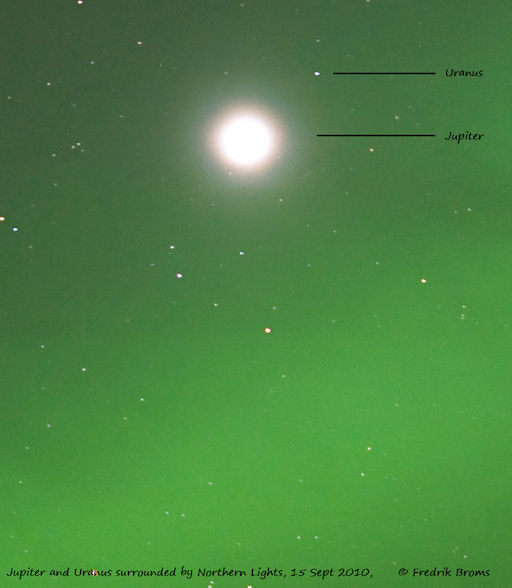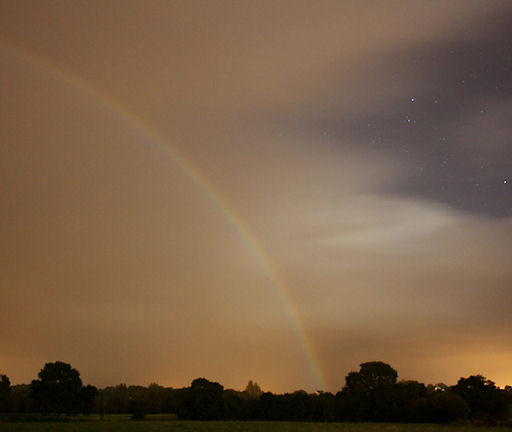iPHONE VS ANDROID! Actually, it doesn't matter which phone you carry. Our cool, new app turns both smartphones into field-tested satellite trackers. Learn more. | | |
WILD AURORAS: A solar wind stream is buffeting Earth's magnetic field and lighting up the Arctic Circle. "The auroras were wild last night," reports Thomas Hagen of Tromsø, Norway. "They danced for hours; it was fantastic!" High latitude sky watchers, if it's dark where you live, be alert for wild auroras.
JUPITER AND URANUS: Jupiter is at opposition on Sept. 21st, meaning the giant planet will be directly opposite the sun, soaring overhead at midnight with dazzling brilliance. In a coincidence of interplanetary proportions, Uranus is at opposition on the very same night! Fredrik Broms of Kvaløya, Norway caught the two converging during a geomagnetic storm on Sept. 15th:

"It's amazing to be able to observe two giant planets next to each other--and never have I seen such a pair against a completely green background!" says Broms.
While Jupiter is outshining everything in the midnight sky (except the Moon), Uranus is barely visible to the naked eye. It's a difference of scale: Uranus is almost three times smaller than Jupiter and five times farther away. Nevertheless, Uranus is still a pretty sight. A telescope pointed at Jupiter on Sept. 21st will reveal the aqua-colored disk of Uranus less than a degree away. And if the sky turns green at the same time, well, that's just a bonus.
more images: from Jean-Paul Godard at Pic du Midi Observatory, France; from Tamas Ladanyi in the Bakony mountains of Hungary; from Peter Rosén of Stockholm, Sweden
RAINBOWS AT NIGHT: The recipe for a rainbow is well known. Add a few thousand raindrops to a bright shaft of sunlight and presto--a colorful arc appears. You might be surprised to learn, however, that sunlight is not required to make a rainbow. Moonlight does just as well:

"Last night I conducted a successful hunt for the elusive Lunar Rainbow," says photographer Martin McKenna of Maghera, Northern Ireland. "I noticed showers moving in from the west, so I drove out to a field and waited. The Moon rose behind me, then in an instant a complete primary and secondary bow formed. I could see them easily with the naked eye complete with colors."
"It was a wonderful experience." The only drawback: "My camera is completely drenched!"
Readers, the Moon is waxing bright. If you hear the pitter-patter of raindrops on your roof, look out the window. You, too, might spy a rainbow at night.
Sept. 2010 Northern Lights Gallery
[previous Septembers: 2009, 2008, 2007, 2006, 2005, 2004, 2002, 2001, 2000]
Potentially Hazardous Asteroids (
PHAs) are space rocks larger than approximately 100m that can come closer to Earth than 0.05 AU. None of the known PHAs is on a collision course with our planet, although astronomers are finding
new ones all the time.
On September 17, 2010 there were 1144 potentially hazardous asteroids.
Notes: LD means "Lunar Distance." 1 LD = 384,401 km, the distance between Earth and the Moon. 1 LD also equals 0.00256 AU. MAG is the visual magnitude of the asteroid on the date of closest approach. | | The official U.S. government space weather bureau |
| | The first place to look for information about sundogs, pillars, rainbows and related phenomena. |
| | Researchers call it a "Hubble for the sun." SDO is the most advanced solar observatory ever. |
| | 3D views of the sun from NASA's Solar and Terrestrial Relations Observatory |
| | Realtime and archival images of the Sun from SOHO. |
| | from the NOAA Space Environment Center |
| | from the National Solar Data Analysis Center |

